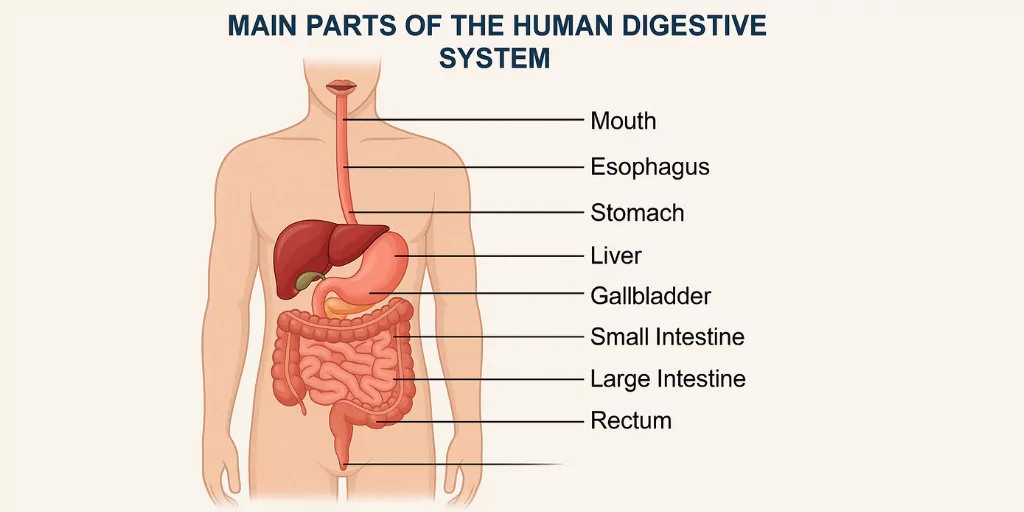The human digestive system is a complicated network of organs that work together to convert the food we eat into nutrients that our bodies can absorb. Each component of this system plays a specific role in the digestion process, from the instant food enters the mouth to the time waste exits the body. Understanding the major components of the digestive system teaches us how our bodies absorb energy and maintain health.
The key components of the human digestive system are:

1. Mouth – Starts the digestion process by chewing and combining food and saliva.
2. Esophagus: The esophagus is a muscular tube that transports food from the mouth to the stomach.
3. Stomach – Uses acids and enzymes to digest food.
4. Small Intestine – The small intestine absorbs the majority of nutrients from digested food.
5. Large Intestine – The large intestine (colon) absorbs water and produces waste.
6. Rectum and Anus – Store and remove solid waste from the body.
Accessory organs (Not part of the food path, but necessary for digestion):
- Liver – Produces bile to help digest fats.
- Gallbladder – Stores and releases bile.
- Pancreas – Secretes enzymes and insulin to help digestion and regulate blood sugar.
Let me know if you’d like a labelled diagram or a student-friendly explanation!
What is the function of the human digestive system?

The function of the human digestive system is to:
Break down food into nutrients that the body can absorb and use for energy, growth, and cell repair.
Key Functions:
- Ingestion – Taking in food through the mouth.
- Digestion – Digestion is the mechanical and chemical breakdown of food into smaller bits.
- Absorption – Nutrients are absorbed into the bloodstream mainly in the small intestine.
- Excretion – The removal of undigested food and waste via the rectum and anus.
In simple terms, the digestive system turns the food you eat into fuel for your body.
The Digestion Process in Humans:

Human digestion is a step-by-step process that converts food into nutrients that our bodies can absorb and use. It includes both mechanical and chemical digestion and goes through the following stages:
1. Ingestion: Food enters the mouth, is chewed, and combined with saliva to start digestion.
2. Propulsion: Food is propelled down the esophagus via peristalsis, a muscle activity that occurs after chewing.
3. Stomach Digestion: Food is broken down into chyme, a semi-liquid form, with the help of digestive fluids and enzymes.
4. Small Intestine Digestion and Absorption: Chyme is mostly digested and absorbed in the small intestine, aided by the liver, gallbladder, and pancreas enzymes.
5. Absorption in the Large Intestine: Remaining material is absorbed by the large intestine and excreted as faeces with water.
6. Elimination: Waste is stored in the rectum and exits the body through the anus.
Conclusion
To summarise, the human digestive system comprises numerous major organs, including the mouth, oesophagus, stomach, small intestine, large intestine, rectum, and anus, which work together to digest and absorb nutrients. Accessory organs such as the liver, pancreas, and gallbladder provide important support. Each component has a vital role in ensuring that our bodies get the energy and nutrients they need to function properly. Understanding these sections allows us to take better care of our digestive health.






